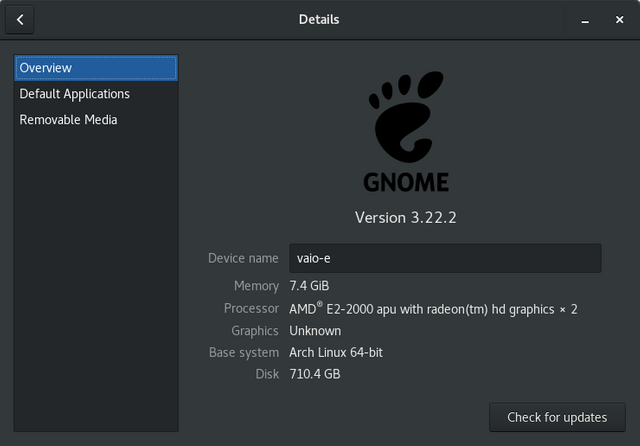Howto: Install Arch Linux the Easy Way
Arch
Linux is possibly the most advanced and fast binary distribution of Linux there is. It does not have releases but rather is on a constant rolling release with a steady stream of package updates. It also has a BSD ports-style system called AUR that can be used to spin up new packages quickly from source packages and repositories.
But it lacks a configuration system for the initial system set up, which has always made me reluctant to switch from Ubuntu.
Those days are no more. There is now a script available called aui which after a few fiddly commands after starting an Arch Linux live image, the rest is menu driven and thorough.
https://github.com/helmuthdu/aui
It has the general instructions but it stipulates at the head of the document you need to have a network connection. If you have an ethernet cable to an internet connected router (or further inside a LAN) you don't need to think about this.
But if you, like me, don't have such a device handy you can use USB tethering, though there is an easy program to connect to wifi, but this has the caveat that you have to reboot once you have installed NetworkManager. This can all be done after you boot first time.
The wifi program is called wifi-menu and will most likely detect your wifi adapter, scan and let you pick a hotspot and enter the password.
But in case you need to configure a network device like a USB ethernet connection such as USB tethering, here is how to do that:
Connecting through USB Tethering
First, you need to find out the kooky name that the kernel gives the USB ethernet device once you plug in an Android phone:
ip link show
Which will put something out like this:
1: lo: <LOOPBACK,UP,LOWER_UP> mtu 65536 qdisc noqueue state UNKNOWN mode DEFAULT group default qlen 1000
link/loopback 00:00:00:00:00:00 brd 00:00:00:00:00:00
2: enp1s0: <NO-CARRIER,BROADCAST,MULTICAST,UP> mtu 1500 qdisc fq_codel state DOWN mode DEFAULT group default qlen 1000
link/ether 3c:07:71:a2:05:1b brd ff:ff:ff:ff:ff:ff
3: wlp3s0: <NO-CARRIER,BROADCAST,MULTICAST,UP> mtu 1500 qdisc noqueue state DOWN mode DORMANT group default qlen 1000
link/ether ba:8f:3e:b6:d2:36 brd ff:ff:ff:ff:ff:ff
4: enp0s18f2u1: <BROADCAST,MULTICAST,UP,LOWER_UP> mtu 1500 qdisc fq_codel state UNKNOWN mode DEFAULT group default qlen 1000
link/ether 5a:9b:19:59:99:01 brd ff:ff:ff:ff:ff:ff
enp0s18f2u1 is the untypeable name of the one I get, probably it's the same for any android device, I couldn't be sure, they are usually a bit weird though.
Next you need to activate it:
ip link set enp0s18f2u1 up
And finally, get an IP address from the NAT router inside the phone that allows all types of tethering:
dhcpcd -h enp0s18f2u1
This puts a bunch of output on the screen talking about asking for and getting DHCP leases, and then you are online.
Running the Installer Script
Next, you want to follow the instructions here: https://github.com/helmuthdu/aui
But the quickest way is at the bottom of the options:
wget ow.ly/wnFgh -O aui.zip
then you unzip it:
unzip aui.zip
cd into the directory it makes (probably aui), and:
./fifo
This has a series of menus you need to enter various details like keymap, the partitons, setting up the base system, and installing the bootloader. After that there is a script called lilo which you start the same way, which I skipped being so overjoyed just to get a booting Arch Linux, but that will set up your GUI as well as some other things. I just did this:
pacman -S gnome gnome-extra
but then had problems with NetworkManager which I had to manually set up, and so on. It took me a while, I wish I'd paid closer attention to the information about lilo.
I also had problems booting the Arch ISO from grml-rescueboot on Ubuntu 16.04, so I had to write the standard current Arch live image to my new fast Sandisk 'ultra fit' which falsely claims 150Mb/s transfer, but in reality it runs at about 50Mb/s though I think if blocks are aligned better maybe it can do more like 75Mb/s. Suffice it to say that even at 50Mb/s it is comfortable and in fact noticably faster most of the time than the 100Mb/s that the spinning disk inside my laptop has.
After putting that on it, I boot it, press 'e' to edit the boot entry and add copytoram to it (I have 8Gb but it's only 450Mb anyway) so that I could unmount the stick, repartition it (I wiped the MBR with dd then partitioned with cfdisk with a new gpt partition table for UEFI) set 1 small partition (about 300Mb minimum) as an EFI system partition, format it with fat32, and the rest I made into an ext4 partition for the system. No swap, since I have enough memory.
Finally a way through the pain of initial setup!
The main thing is, for people like me, with not so much patience for the tedium of manually following a very long series of instructions, the question and answer format makes it so much simpler.
If you have some skills with a linux shell and have wanted to tinker with Arch Linux, the aui script gets all that tricky stuff out of the way for you so you can run it on your hardware. The base that is set up by fifo is a perfect base for a server or even a docker image.
So I now have a nice, fast Arch Linux installation with Gnome 3 installed and Terminator terminal emulator, Chromium, and a bunch of other nicknacks though I'm not going to do much on this laptop itself (mainly on the servers until I have got the Sybil Workshop running) and for that I just need python and virtualenv. By default on Arch that is Python 3.6, the nearly latest version, and as the screenie at the top shows, it is Gnome 3.22.2, which probably isn't far behind the latest of that as well.
It runs so beautifully now!
We can't code here! This is Whale country!Vote #1 l0k1
Go to steemit.com/~witnesses to cast your vote by typing l0k1 into the text entry at the bottom of the leaderboard.
(note, my username is spelled El Zero Kay One or Lima Zero Kilo One, all lower case)


I'm a big fan of Arch Linux @l0k1 - Working with Arch Linux reminded me a lot of working with my first Linux distribution, Pygmy Linux, back in the 1990s. Pygmy Linux was a trimmed down spin of Slackware which provided users with a simple command line interface only, by default. There was no compiler, no package manager, no desktop environment. Everything was done manually or with hand-written scripts. Pygmy presented a steep learning curve when I was first introduced to Linux and Unix, and it was what I needed to become familiar with the technology and pass my course in operating systems at University.
Running Arch is something I think will appeal to people who like to build their operating systems rather than simply run them.
yup. My first christmas present at the age of 4 was several little Lego sets. I have long dreamed of a software system that plugs together like Lego.
Once I saw my first Sinclair ZX81 the road to Steemit was paved! Those memory fragments dear @l0k1 ... memories that live forever! Lego on old friend! ;)
I always enjoy ideas that make installing Arch easier.
Last we were talking about this topic, the tech guy at the community radio station I volunteer at said he uses Arch at home.
may we always succeed.
follow back @nawar93
to his knowledge. I hope you always succeed his fore again
follow back @nawar93
Getting started with arch was pretty messy. But once I took the plunge it was a sort of revelation. I was working with couple of arch spinoffs like Antergos, Archex, Manjaro, Archlabs etc. But finally decided to go for the true one and setup one of my own. Choose KDE as my DE and after I got it up and running it was pretty light on my machine.After logging in it kinda takes 500 MiB of RAM and seems smooth. May be I have to do much more customization and all. But above all I am enjoying having almost complete control over my machine.
nice guide.
very useful for newbie linux pinguin :)